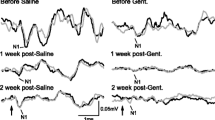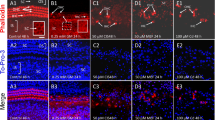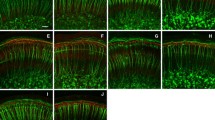Summary
Aminooxyacetic acid (AOAA) is a transaminase inhibitor that has been shown to protect the inner ear from loud noises. This study was done to determine if it can also protect against the cochleotoxic action of gentamicin. Four groups of guinea pigs were injected with gentamicin in doses approximating a clinical therapeutic dose and then in ototoxic doses. Thereafter animals were treated with parenteral AOAA. The effect on hearing was investigated using Preyer's reflex measurements. All animals were sacrificed and their cochleas were examined histologically using the surface preparation technique and mid-modiolar semithin sections. Histocochleograms were plotted to compare the effects of treatment in the animal groups. There was no difference seen among the groups tested. Cochlear damage was nearly equal in all animals, and AOAA was not found to protect the cochlea against gentamicininduced ototoxicity of gentamicin. The mechanism of the ototoxicity produced is discussed on the basis of the findings. Additionally, hair cell degeneration was studied after therapeutic doses of gentamicin. Changes seen were found to be equal to or less than 5% of the hair cells and were scattered throughout the entire cochlea.
Similar content being viewed by others
References
Bobbin RP, Gondra M (1973) Effect of intravenous AOAA on guinea pig cochlear potentials. Neuropharmacology 12:1005–1007
Bobbin RP, Guth PS (1969) Effect of amino-oxy-aceticacid (AOAA) and related agents on hair cell (CM) and VIIth nerve action potential. Fed Proc 28:2885–2889
Bobbin RP, Gozales G, Guth PS (1969) Effect of AOAA on cochlear potentials and the Preyer's reflex. Nature 223:70–71
Bobbin RP, Guth M, Mines A (1976) An examination of an electrochemical mechanism of noise induced hair cell loss: noise with AOAA. Trans Am Acad Ophthalmol Otolaryngol 82:299–304
Engström H, Ades HW, Hawkins JE (1962) Structure and function of the sensory hairs of the inner ear. J Acoust Soc Am 34:1356–1363
Engström H, Ades HW, Anderson A (1966) Structural pattern of the organ of Corti. Almquist and Wiksell, Stockholm
Galic M, Helms J (1982) Elektronenmikroskopische Befunde von Nervus und Ganglion vestibuli bei Morbus Menière. Arch Otorhinolaryngol 236:67–79
Hawkins JE Jr (1973) Ototoxic mechanisms: a working hypothesis. Audiology 12:283–393
Hotta SS (1968) Oxidative metabolism of isolated brain mitochondria: changes caused by aminooxyacetate. Arch Biochem Biophys 127:132–139
Ilberg C von, Spoendlin H, Arnold W (1971) Autoradiographical distribution of locally applied dihydrostreptomycin in the inner ear. Acta Otolaryngol (Stockh) 71:159–165
Kohonen A (1965) Effect of some ototoxic drugs upon the pattern and innervation of cochlear sensory cells in the guinea pig. Acta Otolaryngol (Stockh) [Suppl] 208:1–70
Kuriyama K, Roberts E, Rubinstein MK (1966) Elevation of γ-aminobutyric acid in brain with amino-oxyacetic acid and susceptibility to convulsive seizures in mice; a quantitative re-evaluation. Biochem Pharmacol 15:221–236
Ostyn F, Tyberghein J (1968) Influence of some streptomyces antibiotics on the inner ear of the guinea pig. Acta Otolaryngol (Stockh) [Suppl] 234:1–91
Rubinstein MK, Roberts E (1967) Return of γ-aminobutyrate, transaminase activity in mouse brain after inhibition by amino-oxy-acetic-acid: chemical and histochemical observations. Biochem Pharmacol 16:1138–1140
Spoendlin H, Brun IP (1973) Relation of structural damage to exposure time and intensity in acoustic trauma. Acta Otolaryngol (Stockh) 75:220–226
Tasaki I, Spyropoulos CS (1959) Stria vascularis as a source of endocochlear potential. J Neurophysiol 22:149–155
Ylikoski I (1974) Correlative studies on the cochlear pathology and hearing loss in guinea pigs after intoxication with ototoxic antibiotics. Acta Otolaryngol (Stockh) 326:1–62
Author information
Authors and Affiliations
Additional information
This work was performed in the ENT Department, University of Tübingen, in a cooperative research project between Egypt and the Federal Republic of Germany (Channel System)
Supported by a grant from the “Deutsche Forschungsgemeinschaft” (PL 79/3)
Rights and permissions
About this article
Cite this article
El Begermy, M.A., Galić, M. & Giebel, W. A functional and histological study of the combined effects of gentamicin and aminooxyacetic acid on the organ of Corti of the guinea pig. Arch Otorhinolaryngol 244, 185–189 (1987). https://doi.org/10.1007/BF00464265
Received:
Accepted:
Issue Date:
DOI: https://doi.org/10.1007/BF00464265




